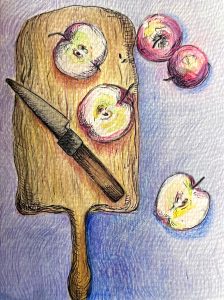I often wonder what non-scientists think of my research: who cares about lizards that they will never see? When I say I study hybrids, do they think I mean hybrid cars? And no, there are no medical applications for my research. Hybridization, or interbreeding between distinct species, of lizards in Argentina is a very foreign idea for most, in more ways than one.
I am a fourth year Ph.D. candidate and I have been interested in hybrid zones for a little while. Hybrid zones offer a unique view into the evolutionary processes that either generate or extinguish species. You see, “species” is a word that the non evolutionary biologist is certainly familiar with, but few know the incendiary debates that regularly occur on campuses worldwide that cover ideas of what defines a species. Just like species, the definition of a species is mutable and evolves over time, largely based on how data are collected. Before Darwin, species have been diagnosed based on morphological (physical/external) characteristics that separate different types of organisms; this lizard is green, and that one is yellow, therefore they are different species. Nowadays, species are mostly being defined based on something all organisms share: DNA.
DNA sequencing technologies that have recently been developed allow us to sequence a large portion of an organism’s genome, therefore shedding light on not only its past, but the past of its ancestors. I still, however, recognize the importance of morphology in determining species limits, those boundaries that separate species. When morphological variation within a “species” is high, it is suspect that more than one species may be present. This point brings us to the lizards!
I am studying a group of lizards in Argentina, the Liolaemus fitzingerii group, that belongs to a lizard genus (Liolaemus) that is confined to South America. This is an exceptional genus of lizards because some species exist at over 5,000m, whereas others are found at sea level; some are herbivorous, and some even give live birth. Furthermore, they are relatively poorly understood and between 10-15 new species are described each year! Regarding the L. fitzingerii group, approximately 15 species are currently recognized, but the geographic and biological boundaries that separate many of these species are not clear.
I have awesome collaborators, Luciano Avila and Mariana Morando, who are researchers at the National Central Patagonia Institute and they have spent their careers trying to describe the diversity of Liolaemus species and understand their evolutionary history. They have studied the L. fitzingerii group for a number of years, mainly because it is a very difficult group to understand. A lot of morphological variation exists within some species in the group, such as L. melanops, where the males can go from having a completely black head, to no black on the head, and everything in between, in the same locality! This makes determining species solely with morphological data a very difficult task.
 |
| The governmental building of my collaborators Luciano Avila and Mariana Morando. Photo by Jared Grummer. |
I have come to Argentina during their summer to sample some putative hybrid zones between some of the L. fitzingerii group “species”. We have sampled one area in Chubut province in particular because the extreme morphological variation seen in this species raises this question if this is a single species, or potentially a hybrid zone between two distinct species. Here is some of the variation in this area:
| Variation in male dorsal patterning from individuals collected at the same locality. Photo by Jared Grummer. |
Variation in male ventral patterning from individuals collected at the same locality. Photo by Jared Grummer.
Sometimes, hybrid zones are found in “ecotones”, where two distinct habitat types come together. However, in this area of Patagonia, the habitat appears to be homogeneous (at least to the human eye).
It is fun to be doing science in an area where Darwin has been! Well, he wasn’t in this exact area, but he was close. In fact, there is a Liolaemus species with his name, L. darwinii, that we have seen a lot during this trip. It was not this species, but Darwin mentions in his notes from the Beagle voyage that he collected a viviparous lizard in Patagonia with a hammer (yikes!).
My collaborator Luciano and I have sampled ~10 sites in northern Chubut and southern Rio Negro provinces spanning an area over 100km that potentially represents a hybrid zone between 2-3 species in the L. fitzingerii group. Now that I have the lizards, the next step will be to collect and analyze DNA from across the genomes of these individuals to see the extent of gene flow between these various populations along a morphological gradient. Half of the vouchers, or physical specimens, will be sent to the Burke Museum of Natural History and Culture; the other half will remain with my collaborators at the National Central Patagonia Institute in Puerto Madryn. These specimens will be a critical reference when analyzing the DNA, as we will be looking for congruence or conflict between morphological and molecular data in this area of putative hybridization between species.

This is my working hypothesis of how hybrid zones have formed. Liolaemus fitzingerii taxa retreated eastward to the historic coastline during Pleistocene glaciation, then expanded westward following glacial retreat and warming temperatures. Species ranges have subsequently come into contact, and hybrid zones are shown in darker grey. Also shown is my hypothesis of genetic diversity as a function of longitude.
I will leave you with some photos of the other cool things that we have been seeing. Stay tuned with results of this research in the spring!
 |
| A gecko, Homonota darwinii, that is one of nine Homonota species in Argentina. Photo by Jared Grummer. |

The herpetology lab in CENPAT where we processed all of our samples. Photo by Jared Grummer.

A southern sea lion colony during breeding season at Punta Norte on the Valdez Peninsula. Photo by Jared Grummer.








